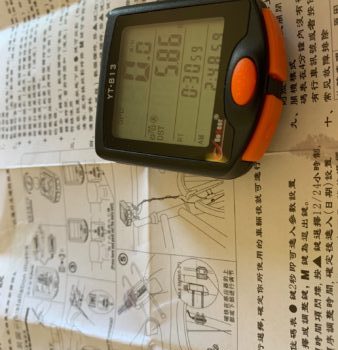
New gadget, new shirt, new year to ride
I rode my bike for the first time this year. It was only 5.75 miles. Half an hour. If I die in Tennessee, it will be because of the hills.
I decided to bike from home, which means I’ve got hills no matter which way I go. I tried a scenic road nearby, that, while narrow, is also pretty sunny, and the hills aren’t too steep.
As I coasted downhill at 18 miles an hour, I dreaded the thought I’d have to ride it back up to get home. I turned around at the top of a hill I knew I wouldn’t want to tackle from the other side. I checked my odometer. Less than 3 miles from home.
How sad is it that I used to ride 20 miles — no problem? I couldn’t do it here. Not with the hills. Maybe I could on flat land, but as I wrote about before, there’s nothing flat in Tennessee.
My sister says it gets better.
What she means is that if I do it often enough, I’ll get stronger and be able to ride further on those damn hills. I’ll have to commit to biking every day that the weather permits. And as much as I love it, it’s daunting.
New gadget, T-shirt
A bright spot, besides the lovely sunshine which got me out on the bike to begin with, is a new gadget. My daughter gave it to me for Christmas. It tracks miles, speed (maximum and average), ride time, temperature, even calories burned. Once I got it installed and programmed, it was pretty easy to use on my ride. That’s how I know how fast I was going down that hill.

I also wore my new Charity Miles T-shirt for the first time. Recently, I got an email explaining I could order one — I didn’t know there were shirts for how many miles you’ve logged for charity. I’m actually at 1,800 miles, so it won’t be too long before I can order the 2,000-mile shirt. If I start biking every day, at 6 miles a day, it will take me a little more than a month to make up the last 200 miles. (After I ordered mine, I saw shirts up to 5,000 miles, but I’ve got years to go before I get there!)
Charity Miles for biking
If you walk, run or bike, you can use Charity Miles to raise money for your favorite charity. (Mine goes to the Alzheimer’s Association.) Each mile walked equals a quarter; each mile biked is a dime. The money comes from businesses that use it instead of advertising dollars. When I click to start a walk or ride, I see who is sponsoring me. When I post to social media from the app, an automated message offers a shoutout to my sponsor. (I could change the message, but I don’t.) It’s an interesting way of advertising or marketing a business to a target audience (active people who support nonprofits). It’s really a winning situation for everyone involved.
It’s a great app, and I strongly encourage you to try it and use it. After you set up your account, you only have to turn it on when you start and off when you stop. Once you’ve used it a few times, you’ll remember it each time you walk, run or bike.
I really have no excuse not to bike more. Now, I have the time. The weather is better than Wisconsin, for sure. My new gadget will track my speed and miles as I ride. Charity Miles will benefit. I won’t die, and the hills will get easier.
Heck, I might even be able to get back to 20-mile rides. If only they were all downhill …
Be a Better Writer Tip
Journalists tend to write short sentences and short paragraphs. Newspaper style is to keep things pretty simple – so readers of all abilities can understand. Short sentences are easier to understand. Short paragraphs are easier to digest.
At one time, it also made it easier to cut from copy on a page. It’s easier to lop off a paragraph than to try and cut a sentence out of a paragraph.
My writing style still tends to follow this format of starting new paragraphs often. However, sometimes, it makes sense to have a longer paragraph. You’ll notice a couple of those in this post.
If you tend to write long – which many writers do – try varying the length of your sentences and paragraphs. It’s OK to have a one-sentence paragraph. A one-sentence paragraph can have impact for your reader – both visually and contextually.
Note my one-sentence paragraph in this column: “My sister says it gets better.” I could have used that as the first sentence of the paragraph following, but it works better on its own. It causes the reader to stop at the period. It gives a moment for the idea to sink in. Try it in your writing, and see how it works.




2 COMMENTS
Loved this column. Great help for writers. I need to purchase a bike.
Thank you, June. I’m glad it was helpful — and inspirational.